How To Apply Eye Cream Like A Professional: 6 Easy Steps + Expert Tricks

Upon first glance, applying eye cream seems like a simple process. Just tap and go, no? At least, that's how the professionals make it look, swiping at the delicate skin with expert-level precision. But, sigh, it's usually not that straightforward: Depending on your cream of choice, you may have to use it at different points of your routine to fully reap the de-puffing or brightening benefits. And if you smear on too much product? Hello, heavy, goopy eyelids.
Your eye area is the thinnest and most delicate skin on your face, the first to betray aging, dryness, or a night of poor sleep—all the more reason to make sure you apply your undereye products properly. So let's break it down, shall we? We tapped the experts on how to apply eye cream like a pro:
Step 1: Choose your product.
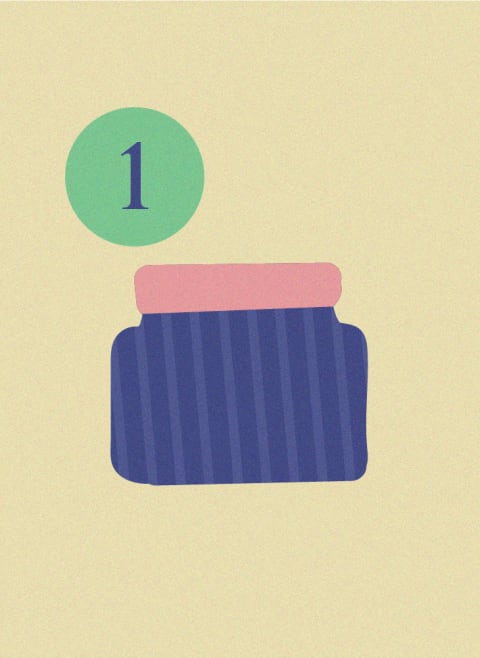
Arguably the most important part of applying eye cream—you need to be smart about your ingredients. After all, someone hoping to banish dark circles may need an entirely different product from someone trying to smooth out fine lines. The below list is nonexhaustive, but take a quick peek to determine which treatments are best for different under-eye concerns:
- Puffiness: For swollen eye bags, look for an eye cream with caffeine. Caffeine is a vasoconstrictor (it compresses blood vessels in the skin), which can help reduce flushing and inflammation—both of which can lead to puffiness. Banana extract is also a star ingredient: "The high level of potassium in bananas helps counteract the salt that leads to fluid retention," writes integrative medicine physician Bindiya Gandhi, M.D., about puffy eyes.
- Fine lines: For under eye wrinkles, look for creams featuring algae (which can inhibit enzymes that break down collagen and help manage photoaging), antioxidants, and peptides. Stimulating collagen production helps keep the skin firm and taut, and antioxidant-rich ingredients help manage oxidative stress that can lead to fine lines.
- Dark circles: Brightening ingredients are top-notch for dark circles, like vitamin C, arbutin, kojic acid, or niacinamide. Caffeine also works wonders, as the ingredient (usually listed as green tea) also contains antioxidant properties that derms say "wake up" tired-looking skin.
- Dry skin: For flaking, irritation, or general dryness, load on the hydrating ingredients. Think hyaluronic acid, aloe, colloidal oat, squalane, and so on.
Of course, you can find an eye cream that folds ingredients from each category into one jam-packed product (see our list of favorites for more than a few). Just identify your main undereye concern and try to find those ingredients at the forefront of the formula.
Step 2: Know when to use it.
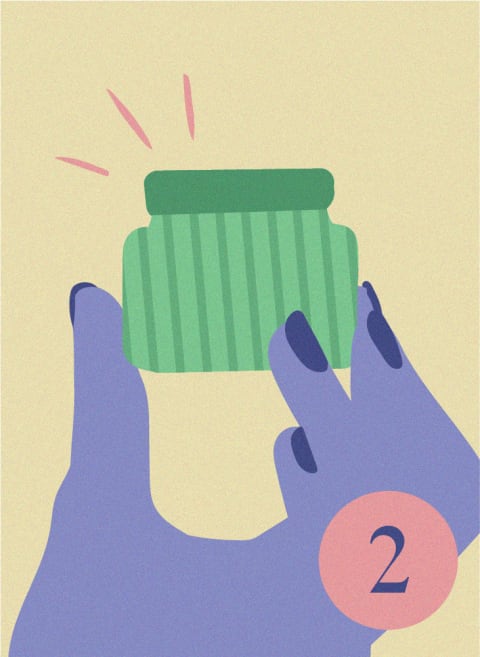
One common question beauty experts receive: At what point do I add an eye cream to my skin care routine? Again, take a look at those ingredients! If your eye cream contains active ingredients (like caffeine, vitamin C, and the like), you should apply it on clean skin so said ingredients can do their job most effectively—a thin, serum-like eye cream can't penetrate past a thick glob of moisturizer.
On the other hand, if you have a creamy product on-hand to hydrate the undereye area, you can apply it after your serum, alongside your moisturizer. Tinted eye creams can go at the very end, as it's more of a skin-care/concealer hybrid.
Step 3: Use a pea-size amount.
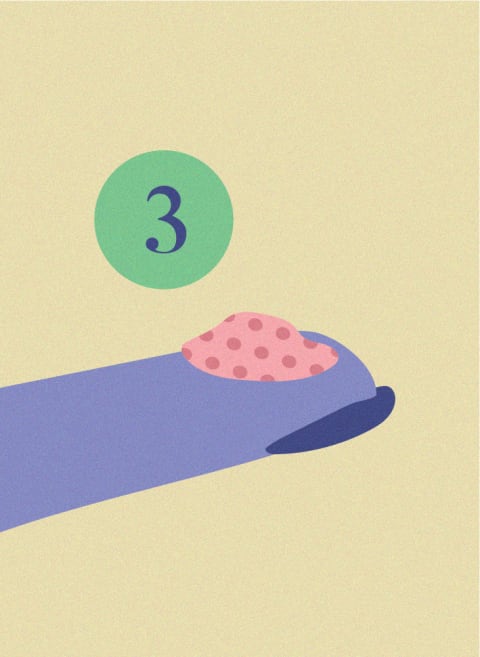
Now, let's get into the actual application bit. A little goes a long way when it comes to eye cream—most experts recommend just a pea-size amount for the entire under-eye. "If you use too much, you can get the product into the eye itself," says Joanna Vargas, celebrity facialist and founder of Joanna Vargas Salons and Skin Care. "It can lead to irritation since that area is so sensitive."
If you notice any milia around the eye area (it's quite common around the eyes and lips, where the skin is thinner), that may also be a sign you're either using too much product or one that's too heavy for your skin. See, too-heavy creams and oils can trap keratin in the pores and cause those tiny white or yellow bumps, which is why experts recommend checking your skin care products as a first step.
Step 4: Gently tap along the undereye.
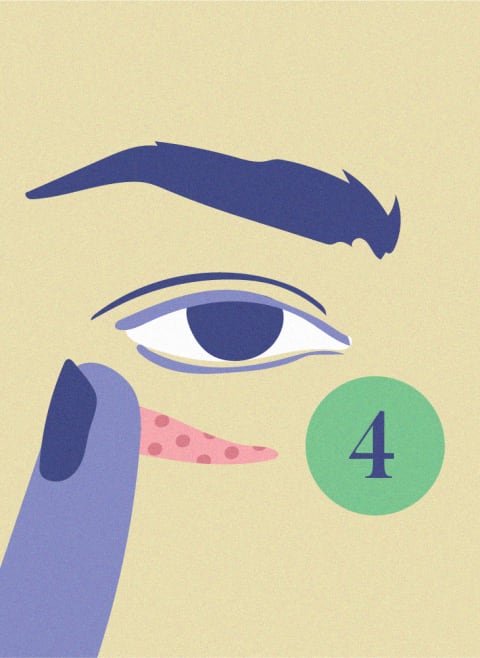
While you may love working in your serums and moisturizers with a gentle massage, the eye area is much more thin and delicate—too much pressure can tug at the fragile skin, which can only exacerbate fine lines and irritation. Vargas seconds the notion: "I would pat or very gently tap on an eye cream. The skin there is so delicate and sensitive," she tells mbg about pressing in skin care products.
Dab your pearl-size amount of product in a semicircle along the undereye area, gently tapping with your finger to blend it in. Many experts recommend using your ring finger or pinkie finger, as those tend to be your weakest digits.
Step 5: Move up to the brow bone.
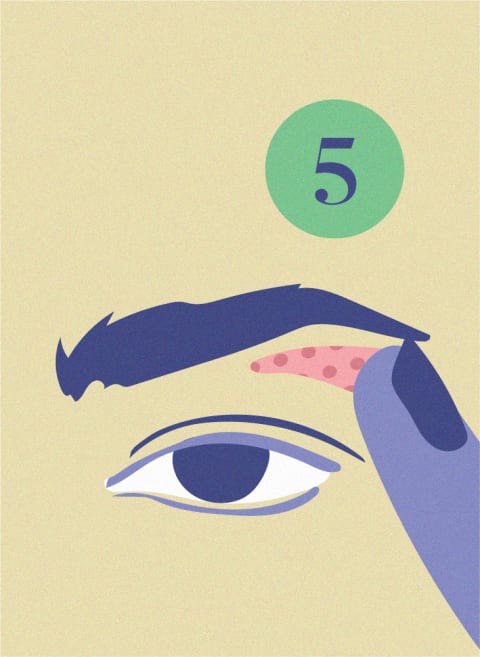
If you so choose, Vargas notes you can venture up to the brow bone, continuing with gentle taps. Just make sure not to go too far down the lid: Again, you don't want to smear product in your eye or pull on the lid skin. A good rule of thumb is to "tap around [the] orbital bone," esthetician Tami Blake, founder of Free + True, previously told us.
Step 6: Let it sink in for about a minute.

Especially if you're planning on wearing makeup, let the product seep into your skin for a beat before continuing with your routine. You don't want to apply concealer or sunscreen too eagerly—this can smear the product. Let the active ingredients do their work! You don't have to wait too long—around 30 seconds to a minute should do the trick, and then you can carry on.
Extra eye cream tips.
You've got the basics down, but there are a few ways to give your orbs a little something extra. On days you feel like pampering the undereyes, take a peek below:
- Stash it in the fridge: Remember when we discussed vasoconstriction up top? Well, a chilly temperature can also constrict the blood vessels in your skin. Toss your product in the fridge for a few minutes before applying, and you'll have a lovely cooling sensation to pair with your cream. It's like giving puffiness and dark circles an extra nudge.
- Pinch the brows: Vargas likes to end her eye-cream treatment with small pinches on the brow bone, which can help stimulate circulation and provide lift. Brow pinching has roots in Ayurvedic medicine, meant to target certain pressure points to reduce puffiness and fine lines. Again, just be gentle on the area—think quick, small pinches with medium pressure rather than death gripping the brows.
- Use a massage tool: If you have an eye massage tool (they typically resemble wands, spoons, or mini mushrooms), you can give yourself a gentle massage. Just be extra careful with the fragile area, and only use the weight of the tool to slide across the skin after applying eye cream. Says Vargas, "I would do tiny circles in an outward motion toward the temples to de-puff the eyes. You see a result the next morning if you do it." It's definitely not necessary every time you apply eye cream, but if you do have a tool on-hand, it's a fun little treatment to help puffiness subside (this brightening number even comes with a handy applicator attached).
The takeaway.
Eye creams may cover only a tiny surface area, but the loaded formulas can work like a charm—assuming you use them correctly. Follow the steps above to apply the product like a pro.

Jamie Schneider is the Beauty Editor at mindbodygreen. She has a B.A. in Organizational Studies and English from the University of Michigan, and her work has appeared in Coveteur, The Chill Times, and more. In her role at mbg, she reports on everything from the top beauty industry trends, to the gut-skin connection and the microbiome, to the latest expert makeup hacks. She currently lives in Brooklyn, New York.